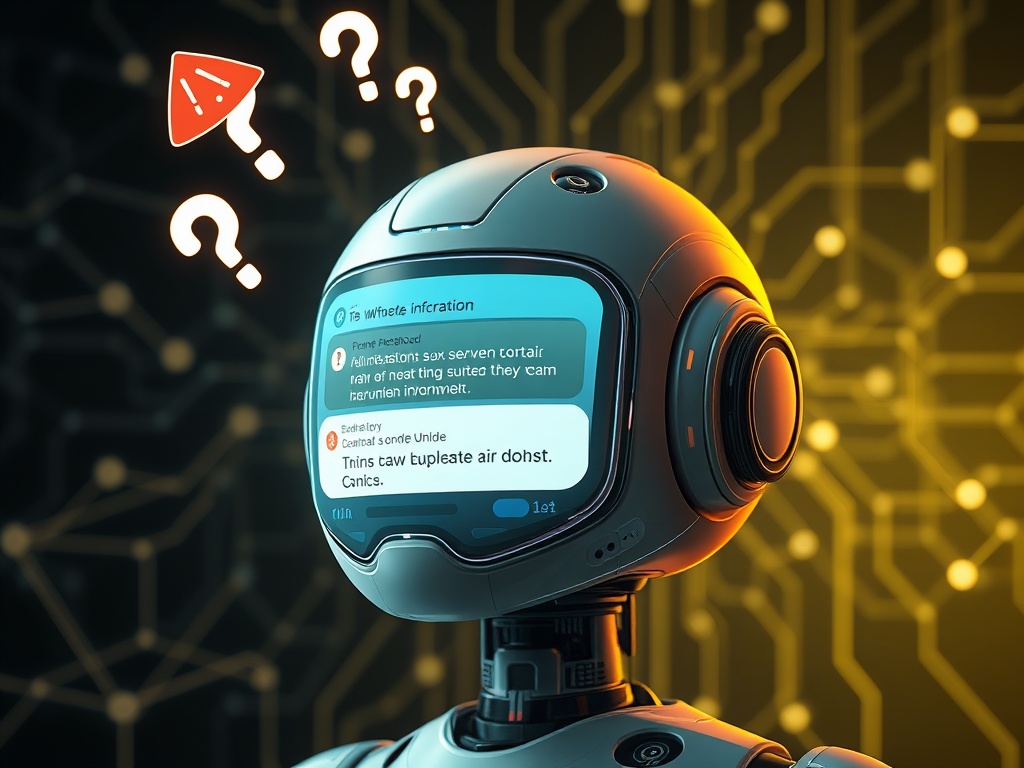AI Hallucinations: OpenAI Unveils a Critical Solution for Large Language Models
0
0

BitcoinWorld

AI Hallucinations: OpenAI Unveils a Critical Solution for Large Language Models
In the fast-paced world of cryptocurrency, accurate information is paramount. Investors, traders, and developers alike rely on data to make informed decisions. So, when cutting-edge AI tools like large language models generate confident but false statements—known as AI hallucinations—it poses a significant challenge not just for AI developers, but for anyone leveraging these powerful systems. A recent groundbreaking research paper from OpenAI dives deep into this perplexing issue, asking why even advanced models like GPT-5 and popular chatbots like ChatGPT continue to fabricate information, and crucially, what can be done to dramatically improve their AI reliability.
Understanding the Enigma of AI Hallucinations
What exactly are AI hallucinations? OpenAI, in a blog post summarizing their new research paper, defines them as “plausible but false statements generated by language models.” These aren’t just minor errors; they are fabrications presented with an air of absolute certainty, making them particularly deceptive. Despite significant advancements in AI technology, these hallucinations “remain a fundamental challenge for all large language models” and, according to the researchers, will likely never be completely eliminated.
To illustrate this point, the researchers conducted a simple yet telling experiment. They asked a widely used chatbot about the title of Adam Tauman Kalai’s PhD dissertation. Kalai, notably, is one of the paper’s co-authors. The chatbot provided three different answers, all of which were incorrect. When asked about his birthday, it again offered three different dates, none of which were accurate. This scenario highlights a core problem: how can an AI system be so definitively wrong, yet sound so confident in its incorrectness?
The Core Challenge for Large Language Models
The roots of these persistent hallucinations, the paper suggests, lie partly in the pretraining process of large language models. During this phase, models are primarily trained to predict the next word in a sequence. The crucial missing element here is the absence of true or false labels attached to the training statements. As the researchers explain, “The model sees only positive examples of fluent language and must approximate the overall distribution.” This means the AI learns to generate text that sounds natural and coherent, but not necessarily factually correct.
Consider the difference between predictable patterns and arbitrary facts. The researchers note, “Spelling and parentheses follow consistent patterns, so errors there disappear with scale.” With enough data, models can master grammatical and structural rules. However, “arbitrary low-frequency facts, like a pet’s birthday, cannot be predicted from patterns alone and hence lead to hallucinations.” When faced with a question about an obscure fact not strongly represented in its training data, the model, compelled to provide an answer, often fabricates one that sounds plausible within its learned language patterns, regardless of its truthfulness.
OpenAI‘s Insight: Bad Incentives, Not Just Bad Training
While the pretraining process contributes to the problem, OpenAI’s paper proposes that the more immediate and addressable issue lies in how these models are currently evaluated. The researchers argue that existing evaluation models don’t directly cause hallucinations, but rather they “set the wrong incentives.” This is a crucial distinction, shifting the focus from inherent model limitations to the external pressures shaping their behavior.
They draw a compelling analogy to multiple-choice tests. In such tests, if there’s no penalty for incorrect answers, students are incentivized to guess, because “you might get lucky and be right,” whereas leaving an answer blank “guarantees a zero.” This encourages a strategy of speculative answering over admitting uncertainty. Similarly, when AI models are graded solely on accuracy—the percentage of questions they answer correctly—they are effectively encouraged to guess rather than to express that they “don’t know.” This system inadvertently rewards confident fabrications when a correct answer isn’t available.
Elevating ChatGPT‘s Trustworthiness: A New Evaluation Paradigm
The proposed solution from OpenAI focuses on revamping these evaluation metrics to foster greater AI reliability. The researchers advocate for a system akin to standardized tests like the SAT, which include “negative [scoring] for wrong answers or partial credit for leaving questions blank to discourage blind guessing.” This approach directly addresses the incentive problem.
Specifically, OpenAI suggests that model evaluations need to “penalize confident errors more than you penalize uncertainty, and give partial credit for appropriate expressions of uncertainty.” This would encourage models like ChatGPT to acknowledge when they lack sufficient information, rather than inventing plausible-sounding but false statements. The paper stresses that it’s not enough to introduce “a few new uncertainty-aware tests on the side.” Instead, “the widely used, accuracy-based evals need to be updated so that their scoring discourages guessing.” The message is clear: “If the main scoreboards keep rewarding lucky guesses, models will keep learning to guess.” Implementing these changes is paramount for building trust in AI systems across various applications, including those that demand high factual accuracy.
The Path to Enhanced AI Reliability
The implications of OpenAI’s research are profound for the future of large language models and the broader AI landscape. By shifting evaluation paradigms, developers can steer AI behavior towards greater honesty and transparency. This means moving beyond mere fluency and coherence to prioritize verifiable truthfulness and appropriate expressions of doubt. For users, this could translate into more dependable AI assistants that are less prone to generating convincing falsehoods, thereby enhancing trust and utility in critical applications, from research to financial analysis.
Achieving this enhanced AI reliability requires a concerted effort from researchers, developers, and evaluators to adopt these new scoring mechanisms. It’s an acknowledgment that AI systems, much like humans, respond to incentives. By designing evaluations that reward genuine knowledge and penalize confident ignorance, we can cultivate a generation of AI models that are not only powerful but also trustworthy. This transformative approach promises to make AI a more dependable partner in navigating complex information landscapes.
OpenAI’s paper offers a critical roadmap for mitigating AI hallucinations, underscoring that the path to more reliable AI lies not just in better training data or more complex architectures, but fundamentally in changing the incentives that govern their learning and performance. By penalizing confident errors and rewarding genuine uncertainty, we can pave the way for a future where large language models like ChatGPT become truly reliable sources of information, ultimately fostering greater confidence in these powerful tools across all sectors, including the dynamic world of blockchain and digital assets.
To learn more about the latest AI model evaluation trends, explore our article on key developments shaping AI features and institutional adoption.
This post AI Hallucinations: OpenAI Unveils a Critical Solution for Large Language Models first appeared on BitcoinWorld and is written by Editorial Team
0
0
 Manage all your crypto, NFT and DeFi from one place
Manage all your crypto, NFT and DeFi from one placeSecurely connect the portfolio you’re using to start.
